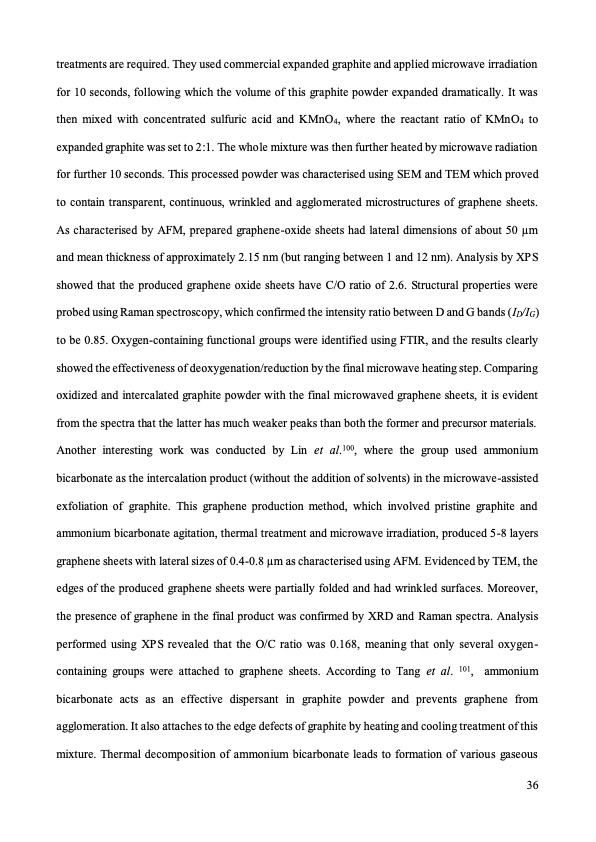PDF Publication Title:
Text from PDF Page: 036
treatments are required. They used commercial expanded graphite and applied microwave irradiation for 10 seconds, following which the volume of this graphite powder expanded dramatically. It was then mixed with concentrated sulfuric acid and KMnO4, where the reactant ratio of KMnO4 to expanded graphite was set to 2:1. The whole mixture was then further heated by microwave radiation for further 10 seconds. This processed powder was characterised using SEM and TEM which proved to contain transparent, continuous, wrinkled and agglomerated microstructures of graphene sheets. As characterised by AFM, prepared graphene-oxide sheets had lateral dimensions of about 50 μm and mean thickness of approximately 2.15 nm (but ranging between 1 and 12 nm). Analysis by XPS showed that the produced graphene oxide sheets have C/O ratio of 2.6. Structural properties were probed using Raman spectroscopy, which confirmed the intensity ratio between D and G bands (ID/IG) to be 0.85. Oxygen-containing functional groups were identified using FTIR, and the results clearly showed the effectiveness of deoxygenation/reduction by the final microwave heating step. Comparing oxidized and intercalated graphite powder with the final microwaved graphene sheets, it is evident from the spectra that the latter has much weaker peaks than both the former and precursor materials. Another interesting work was conducted by Lin et al.100, where the group used ammonium bicarbonate as the intercalation product (without the addition of solvents) in the microwave-assisted exfoliation of graphite. This graphene production method, which involved pristine graphite and ammonium bicarbonate agitation, thermal treatment and microwave irradiation, produced 5-8 layers graphene sheets with lateral sizes of 0.4-0.8 μm as characterised using AFM. Evidenced by TEM, the edges of the produced graphene sheets were partially folded and had wrinkled surfaces. Moreover, the presence of graphene in the final product was confirmed by XRD and Raman spectra. Analysis performed using XPS revealed that the O/C ratio was 0.168, meaning that only several oxygen- containing groups were attached to graphene sheets. According to Tang et al. 101, ammonium bicarbonate acts as an effective dispersant in graphite powder and prevents graphene from agglomeration. It also attaches to the edge defects of graphite by heating and cooling treatment of this mixture. Thermal decomposition of ammonium bicarbonate leads to formation of various gaseous 36PDF Image | graphene production via nonoxidizing liquid exfoliation

PDF Search Title:
graphene production via nonoxidizing liquid exfoliationOriginal File Name Searched:
Graphene-R2-review.pdfDIY PDF Search: Google It | Yahoo | Bing
Salgenx Redox Flow Battery Technology: Power up your energy storage game with Salgenx Salt Water Battery. With its advanced technology, the flow battery provides reliable, scalable, and sustainable energy storage for utility-scale projects. Upgrade to a Salgenx flow battery today and take control of your energy future.
CONTACT TEL: 608-238-6001 Email: greg@infinityturbine.com (Standard Web Page)